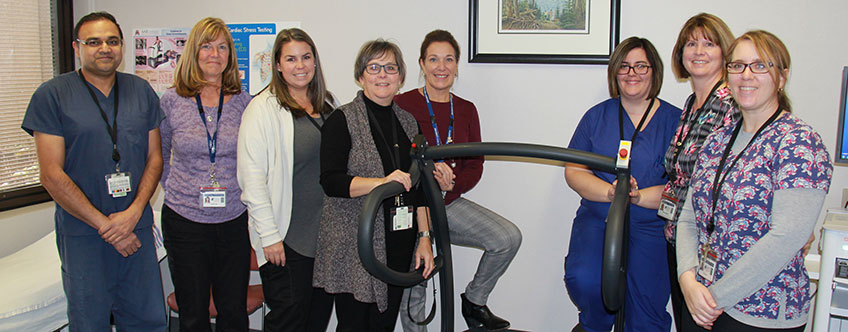Cardiology Services (formally referred to as Electrodiagnostic Services and/or EDS) provides a number of non-invasive diagnostic procedures. The majority of these tests are cardiac (heart) investigations including ECG, Stress Testing, Echocardiography, Arrhythmia and Pacemaker management, Holter Monitoring, and Ambulatory Blood Pressure Monitoring.
Our Cardiology department also provides a neurological service of electroencephalography (EEG). All Cardiology appointments are by physician referral.
Below you will find a brief description of a few of the many tests we perform. Please see your physician for specific instructions pertaining to your individual exam and to answer questions regarding your results.
Electrocardiography (ECG)
This test is also called an ECG or an EKG. It is a simple painless test that records the electrical activity of the heart. You may be asked to change into a gown. Electrodes are placed on your chest, arms and legs and are then connected to a monitor to record these electrical signals.
Stress Test
An exercise stress test is a screening tool used to test the effect of exercise on your heart. The technologist will place electrodes on your chest which are attached to a monitor that records the electrical activity of your heart. You will walk on a treadmill and at different timed intervals you will be asked to walk faster on an incline (it is like walking fast or jogging up a hill). While you exercise, the activity of your heart is measured and blood pressure readings are taken.
Pacemaker Arrhythmia Services
This is a service is for patients with Pacemakers, Implantable Cardiac Defibrillators and Implantable Cardiac Loops. You will be connected to specialized equipment that can test your device and provide valuable information to your doctor. The technologist/physician can also make the necessary changes to your device through a wand that sits overtop of your device.
Holter Monitoring
Also known as an ambulatory ECG monitor, a Holter Monitor records your heart rhythms for an entire 24 or 48 hour period. Wires from electrodes on your chest go to a battery operated recording device worn on a belt or a shoulder strap. While you are wearing the monitor, you will keep a diary of your activities and symptoms. Your doctor will compare the diary with the electrical recordings.
Ambulatory Blood Pressure Monitoring
This is a blood pressure cuff that is placed on your upper arm that you wear for 24 hours. During this time your blood pressure will be recorded at set intervals or when self-activated as you experience symptoms. You will keep a diary of your activities at the time the blood pressure cuff inflates.
Electroencephalography (EEG)
This test measures brain waves to evaluate your brain wave activity. 22 surface electrodes will be attached to your head with water soluble conductive cream. These electrodes are then connected by wires to equipment that records your brain wave activity. You may be asked during the test to do some deeper breathing as well as opening and closing your eyes. The technologist may also use a strobe light during the procedure. If requested by the physician, you may be asked to not sleep for a specific period of time prior to coming to the hospital for your EEG.
Echocardiography
This test is an ultrasound of your heart. You will be asked to change into a gown and lie on a bed during this procedure. Gel will be placed on your chest in different locations and a transducer or wand will be moved around on your chest area to obtain pictures of your heart (including the walls of the heart and the heart valves).
14 day External Loop Recorders
For this test, you will be given a monitor to take home for 14 days. These monitors are attached to you by wires that are connected to 2 electrodes on your chest. When you experience a symptom, you will press the record button on the monitor and it records a 2 minute ‘snapshot’ of what your heart rhythm is doing at that specific time. You will also be asked to keep a diary of the date and time when you activated the device and provide a brief description of the symptom. You may then phone into the Pacemaker Clinic once these events have been recorded to download these episodes over the telephone into our database.
Patient Education: Stress Echo
Patient Education: Transesophageal Echocardiography (TEE) Patient Information Guide

